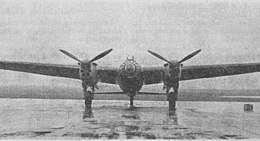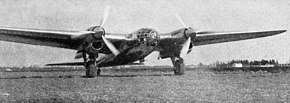Amiot 354
The Amiot 354 was the last in a series of fast, twin-engine bombers which fought with the French Air Force in limited numbers during the Battle of France.
| 354 | |
|---|---|
 | |
| Amiot 351 | |
| Role | Bomber |
| Manufacturer | Avions Amiot |
| Introduction | 1940 |
| Primary user | French Air Force |
| Number built | ca. 86 |
Development

The Amiot 350 series originated in the same 1934 requirement as a rival to the Lioré et Olivier LeO 451. Derived from the Amiot 341 mail plane, the Amiot 340 prototype was involved in a propaganda misinformation flight to Berlin in August 1938 to convince the Germans that the French employed modern bombers. Though 130 machines were ordered by the French government that year, production delays and ordered modifications ensured that September 1939 saw no delivered aircraft. Eventually, the ordered number of this very modern aircraft reached 830, though ultimately only 80 machines were received by the Air Ministry. The main variant was the twin-tailed 351; however, due to various delays, the single-tailed 354 was accepted into service as an interim type.
The Amiot 351 was planned to mount one 7.5 mm (.295 in) MAC 1934 machine gun in nose and ventral positions and one 20 mm (0.79 in) Hispano-Suiza HS.404 cannon in the dorsal position. Due to technical problems with the armament installation, many aircraft went to operational units with only a rifle-calibre light machine gun in the dorsal position.
Operational history
In May 1940, the Amiot 351/354 was in the process of equipping just two bomber groupes: GB 1/21 and GB II/21 based at Avignon. Though 200 were in the final stages of construction, only 35 were ready for flight. This situation was exacerbated by the Amiot 351/354 being built in three factories, two of which were later bombed by the Germans. On 16 May 1940, the Amiot 351/354s carried out armed reconnaissance sorties over Maastricht in the Netherlands - the first operation conducted by planes of this type. By June, the Amiot 351/354 was also delivered for GB I/34 and GB II/34, neither flying them in combat. At that time, all Amiot 351/354s were based on the northern front. Three had been lost in combat and ten in training accidents. All aircraft were ordered to evacuate to Africa on 17 June, 37 surviving the trip. As their numbers were too few to engage the Italians, the aircraft were sent back to Metropolitan France and their groupes disbanded in August 1940. Five Amiot 351/354s continued to be used as mail planes after the Battle of France. Four Amiot 351/354s were commandeered by the Luftwaffe as transports, two found service in the 1./Kampfgeschwader 200 a special service unit. Engines taken from these aircraft were later used on Messerschmitt Me 323 cargo transports.
Variants

.jpg)


- Amiot 340.01
- Two 686 kW (920 hp) Gnome-Rhône 14P, single-tail prototype (one built)
- Amiot 350
- 351 re-engined with two 686 kW (920 hp) Hispano-Suiza 12Y-28 / Hispano-Suiza 12Y-29 engines (one built)
- Amiot 351.01
- Amiot 351 prototype.
- Amiot 351
- Two 707 kW (950 hp) Gnome-Rhône 14N-38 / Gnome-Rhône 14N-39, twin-tail (17) (This number may be low)
- Amiot 352
- 351 re-engined with two 820 kW (1,100 hp) Hispano-Suiza 12Y-50 / Hispano-Suiza 12Y-51 engines (one built)
- Amiot 353
- 351 re-engined with two 768 kW (1,030 hp) Rolls-Royce Merlin III engines (one built)
- Amiot 354
- 351 re-engined with two 798 kW (1,070 hp) Gnome-Rhône 14N-48 / Gnome-Rhône 14N-49, most with single-tail. (45) (This number is probably low)
- Amiot 355.01
- 351 re-engined with two 895 kW (1,200 hp) Gnome-Rhône 14R-2 / Gnome-et-Rhone 14R-3 engines (one built)
- Amiot 356.01
- 354 re-engined with two 842 kW (1,130 hp) Rolls-Royce Merlin X engines (one built)
- Amiot 357
- high-altitude prototype with pressurized cabin, two 895 kW (1,200 hp) Hispano-Suiza 12Z-89 turbocharged engines (one built)
- Amiot 358
- 351 re-engined post-war with two 895 kW (1,200 hp) Pratt & Whitney R-1830 engines (one built)
- Amiot 370
- single-tail racer with two 642 kW (860 hp) Hispano-Suiza 12Yirs / Hispano-Suiza 12Yjrs engines, developed specifically for (later cancelled) Paris-New York race (one built)
Specifications (Amiot 354 B4)
Data from War Planes of the Second World War: Volume Seven Bombers and Reconnaissance Aircraft [1]
General characteristics
- Crew: 4 (pilot, co-pilot, navigator, bombardier)
- Length: 14.5 m (47 ft 7 in)
- Wingspan: 22.83 m (74 ft 11 in)
- Height: 4.08 m (13 ft 5 in)
- Wing area: 67 m2 (720 sq ft)
- Airfoil: E7[2]
- Empty weight: 4,735 kg (10,439 lb)
- Gross weight: 11,324 kg (24,965 lb)
- Powerplant: 1 × Gnome-Rhône 14N-48 14-cylinder two-row air-cooled radial piston engine, 791 kW (1,061 hp) for take-off (RH rotation fitted to port)
- Powerplant: 1 × Gnome-Rhône 14N-49 14-cylinder two-row air-cooled radial piston engine, 791 kW (1,061 hp) for take-off (LH rotation fitted to starboard)
- Propellers: 3-bladed variable-pitch propellers
Performance
- Maximum speed: 480 km/h (300 mph, 260 kn) at 4,000 m (13,123 ft)
- Cruise speed: 349 km/h (217 mph, 188 kn)
- Range: 3,502 km (2,176 mi, 1,891 nmi)
- Service ceiling: 10,000 m (33,000 ft)
- Time to altitude: 4,000 m (13,123 ft) 8 minutes 42 seconds
Armament
- Guns: 3 × 7.5 mm (0.295 in) MAC 1934 machine guns or 2 × 7.5 mm (0.295 in) MAC 1934 machine guns and 1 × 20 mm (0.787 in) cannon
- Bombs: 1,200 kg (2,646 lb)
See also
Aircraft of comparable role, configuration and era
- Douglas DB-7
- Martin Maryland
- Lioré et Olivier LeO 45
- SNCAC NC.150
Related lists
References
- Notes
- Green 1967, p.92.
- Lednicer, David. "The Incomplete Guide to Airfoil Usage". m-selig.ae.illinois.edu. Retrieved 16 April 2019.
- Bibliography
- Breffort, Dominique & Jouineau, André. French Aircraft from 1939 to 1942
- Green, William. War Planes of the Second World War: Volume Seven Bombers and Reconnaissance Aircraft. London:Macdonald, 1967.
- Weal, Elke C., Weal, John A., Barker, Richard F. Combat Aircraft of World War Two
- Various issues of Avions magazine